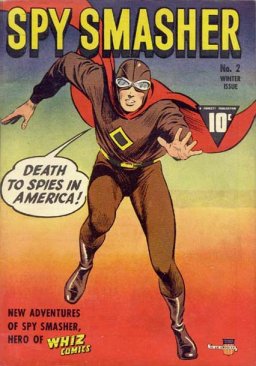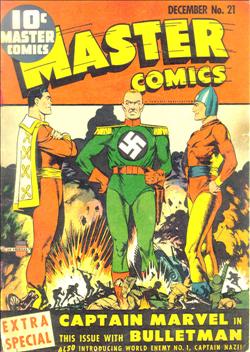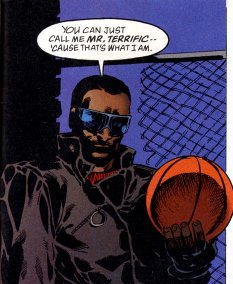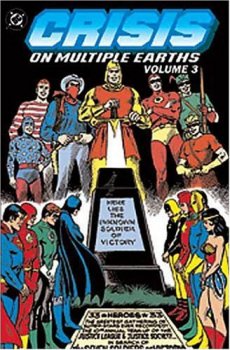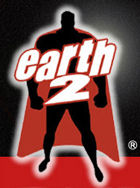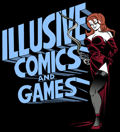But fans' jaws had to drop at Spy Smasher starting off
the episode. Obscure now, but for a very brief period in
the early forties, he was one of the most popular superheroes
in the country.
First appearing in Whiz Comics #2 (the same book
that debuted Captain Marvel), Spy Smasher was really wealthy
Virginia playboy Alan Armstrong. Dating the daughter of
a Senator, Armstrong had a bit of insight into the State
Department's doings in the early days of the war, and used
that knowledge to stop Axis spies in their attempts at espionage.
Apparently, Armstrong was also a genius at combining blueprints,
creating the Gyrosub that this episode has him flying and
diving in.
Of all the characters appearing in this episode, Spy Smasher
has a pretty strong claim to fame. He actually has a film
adaptation, only the second superhero to star in a serial.
The first being …Captain Marvel. No wonder DC sued Fawcett.
After World War II ended, Armstrong briefly changed his
name to Crime Smasher, and what his new name lacked in alliteration
it also lacked in sales. He stopped appearing in comics
sometime in 1947.
Until, that is, "Crisis on Earth-S," one of the annual
JLA/JSA crossovers that DC used to re-introduce the Fawcett
characters to modern readers, where most of them promptly
disappeared again. That story can be found in the upcoming
trade paperback Crisis
on Multiple Earths v.4 ,
and it's well worth it to also see Bulletman and Bulletgirl
(the inspiration for one of Grant Morrison's current Seven
Soldiers, the Bulleteer) and the embarrassingly named Mr.
Scarlet and Pinky. Poor, poor Pinky.
,
and it's well worth it to also see Bulletman and Bulletgirl
(the inspiration for one of Grant Morrison's current Seven
Soldiers, the Bulleteer) and the embarrassingly named Mr.
Scarlet and Pinky. Poor, poor Pinky.
In this episode, Spy Smasher stops the Captain Nazi program,
but in the comics, the overdeveloped Aryan bedeviled several
Fawcett characters. Originating as a foe of Captain Marvel,
Captain Nazi's biggest claim to fame was being not just
a Nazi, but an outright asshole even among his peers.
After Captain Marvel knocked him out of the sky and into
the ocean, Captain Nazi was rescued by a kindly old gentleman
and his grandson out on a fishing trip. Demonstrating the
graciousness that the Third Reich was generally known for,
Captain Nazi killed the old man and crippled the young boy
while bragging about his superiority.
That boy remained crippled, but a guilt-ridden Captain
Marvel took him to the wizard Shazam and begged for magical
intervention. When the lame (I mean that in terms of his
injury) Freddy Freeman spoke the name of his idol, Captain
Marvel, aloud, lightning would flash and imbue Freddy with
the power to be Captain Marvel, Jr.
But let's move up the military echelons, shall we, to
a character known in the pages of JLA as "The General."
Here, Eiling uses the super-soldier formula to mutate, but
in the comics, he actually commandeered the body of a bizarre
Justice League villain from the sixties, the Shaggy Man.
An android with overdeveloped muscles and hair follicles,
the Shaggy Man had been in stasis for decades until Grant
Morrison remembered he existed. A bitter Eiling transferred
his brain into the Shaggy Man's body (he had previously
been pretty much a mindless brute) and then gave the artificial
troglodyte a military cut.
Dubbing himself "The General," he joined with Lex Luthor's
Injustice Society, an alliance that didn't end well. Unlike
his animated counterpart, the General went all-out evil,
not even bothering to mask his hatred of the JLA with the
flag of patriotism.
Meanwhile, back in the private sector, we have the biggest
role yet on JLU for Mr. Terrific, filling in as coordinator
while J'onn J'onnz wanders the Earth like Cain. This incarnation
of Mr. Terrific debuted in The Spectre #54, the great
series written by John Ostrander and mostly drawn by Tom
Mandrake.
Both Misters Terrific, Golden Age and modern, were super-geniuses.
The one appearing in JLU, Michael Holt, had grown
despondent over the death of his wife and their unborn child.
About to commit suicide, Holt was held up by three scared
kids. Before they could shoot him, the Spectre appeared,
drawn by the possibility of preventing a suicide. The ghostly
guardian returned to counsel Holt to be an inspiration to
the street kids and show them a better path than violence,
giving him permission to adopt the identity of the Spectre's
late friend, the original Mr. Terrific.
When Michael Holt appeared again in the pages of JSA,
his character altered a bit to focus more on being the supergenius
and master strategist. He currently leads the group, and
Geoff Johns planted the seeds of a strong friendship between
Mr. Terrific and Batman. The respect came about when Mr.
Terrific's all-purpose "T-Spheres" impressed Batman so much
he ripped them off. Rather than get a lawyer, Holt felt
flattered.
Not named in the episode but surprisingly crucial to it,
Simon and Kirby's Newsboy Legion drive the point home. In
the credits, the only character named is Johnny, the team
leader, except that the comics name him Tommy. This could
be one of those strange DC/WB Animation legal issues.
The others are Big Words, Scrapper and Gabby, though again,
none of them are named here. One of a few "kid gangs" from
the forties, the Newsboy Legion has had a long history of
getting tied in to events in Metropolis. Their original
series followed their misadventures, but was also notable
that they had a costumed protector, The Guardian (who also
now has echoes in Morrison's Seven Soldiers as the Manhattan
Guardian).
When Jack Kirby returned to DC in the early seventies,
he took over Superman's Pal, Jimmy Olsen and brought
back the Newsboy Legion, now adults. Thankfully, they all
had sons that were spitting images, and these youths joined
Jimmy on some extremely wild adventures, occasionally accompanied
by a clone of the original Guardian.
All of these stories can be found in two trade paperbacks
Jimmy
Olsen: Adventures by Jack Kirby - Volume 1 and Volume
2
and Volume
2 , and despite some uneven art (DC sicked Vince Colletta
on Kirby as an inker), they're pretty mindblowing - and
pretty silly.
, and despite some uneven art (DC sicked Vince Colletta
on Kirby as an inker), they're pretty mindblowing - and
pretty silly.
I've covered most of the original Seven Soldiers (who
were really eight) in earlier Continuity Corners, but I
do want to add that DC did see fit to collect their adventures
in The
Seven Soldiers of Victory Archives, Vol. 1 (DC Archive Editions) .
Despite the obscurity of the team, they had some of the
best artists of the forties working on their adventures.
I'm not absolutely positive, but I think that this volume
has all their adventures, as the team did not last long.
They disappeared from public consciousness until another
one of those JLA/JSA team-ups, which can be found in Crisis
on Multiple Earths Volume 3
.
Despite the obscurity of the team, they had some of the
best artists of the forties working on their adventures.
I'm not absolutely positive, but I think that this volume
has all their adventures, as the team did not last long.
They disappeared from public consciousness until another
one of those JLA/JSA team-ups, which can be found in Crisis
on Multiple Earths Volume 3 .
.
